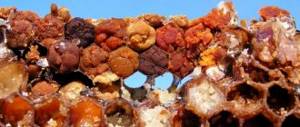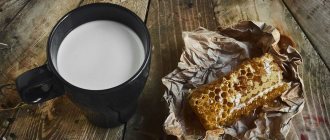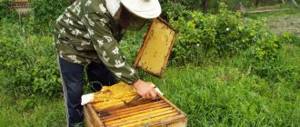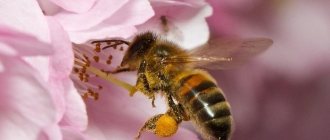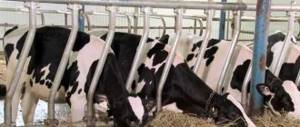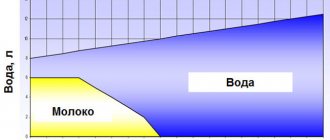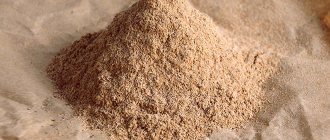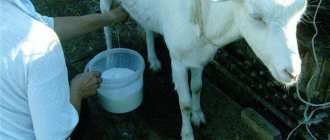Blog articles
Bees
- Types of cells in honeycombs
- Bee honeycombs - what is their biological meaning?
- Physical basis of the design
- Features of the shape of a honeycomb - geometry
- Useful properties of honeycombs
- Care, rejection, replacement of honeycombs
- Service life of honeycombs in a hive
- Using wax to build up honeycombs
- Using old sushi
- Removing brood from honeycombs
- Useful properties of comb honey
- Photos of amazing and unusual honeycombs in a hive
Honeycombs are rightfully a miracle of nature. Honeycombs are hexagonal cells produced by bees for storing honey reserves and raising brood. Interestingly, their sizes differ depending on the purpose. The production of honey is the result of the painstaking work of the beekeeper and all the inhabitants of the hive. The beekeeper's task is to protect the health of the bee family and provide a sufficient amount of everyone's favorite delicacy. And it is directly related to the state of the cells.
Why are honeycombs hexagonal?
The wax cells filled with golden sweet nectar are nothing less than a work of engineering art. The design is based on a hexagon of regular shape, surrounded by many cells of the same shape.
Interesting fact. The first of the outstanding beekeepers to create a frame hive was Pyotr Ivanovich Prokopovich. He made his own hive in 1814.
The philosopher Pappus of Alexandria, who lived in Ancient Greece, believed that bees have a unique ability - geometric foresight. And he was sure that only the Lord could endow insects with such knowledge. There were many other theories that were based on speculation and reasoning.
Charles Darwin was not sure of any of them, and rejected their realism. He spent a long time conducting experiments in an attempt to find out whether honey insects could build ideally shaped wax cells, guided only by innate and acquired skills, as stated in the theory of evolution.
Bees create not only hexagonal honeycombs, but also pentagonal ones. Pentagonal honeycombs are located between small and large honeycombs.
Darwin was still tormented by the same question - why are honeycombs hexagonal? It turns out this has a fairly simple explanation. If you try to fill any plane so that there are no empty spaces left, only three geometric shapes will be suitable, the sides and angles of which are equal, namely:
- hexagons (better known as regular hexagons);
- triangles;
- squares.
When choosing from the above figures, it can be noted that the best option is a hexagon. Cells of this shape require shorter length and width of partitions, which cannot be said about squares and triangles of the same area.
Why do bees make honeycombs in the shape of a hexagon? The love of honey insects for hexagons is completely justified and can be explained logically.
The hexagonal shape is the most economical and efficient shape for honeycomb construction.
To produce wax to build cells, bees use a lot of time and energy resources. That is why they are trying to reduce the amount of material spent on construction. For clarity, you can pay attention to builders who are trying in every possible way to minimize the cost of bricks and materials necessary for construction.
It was possible to draw such a conclusion only in the 18th century. Charles Darwin explained that the hexagonal shape is an ideal shape that reduces the cost of wax and bee labor.
What is a honeycomb
Did you know that bees use the Earth's magnetic field as a guide when building honeycombs? Bee honeycombs are wax cells designed to store nectar and convert it into honey. Small bees (brood) are also grown in honeycombs. A wax structure is built from wax, which is secreted along with the secretion of special glands. Bees spend an average of 10–15 mg of wax to build one comb.
Cell structure and shape
The shape of a bee's honeycomb is a regular hexagonal prism. This geometric shape allows you to use the available space with utmost efficiency - there is no free space left between the cells. In addition, the insect requires less wax to build the walls, and the structure itself is durable.
According to the researchers, the hexagonal shape is not a manifestation of the bees' engineering skills. During the observations, scientists noticed that initially the cells were round, and the working individuals filled the gaps between them with wax. Since bees warm up the hive by contracting their muscles to develop heat-loving larvae, the wax softens and becomes more plastic. The force of surface tension prevents the cell from spreading out and gives it the correct geometric shape.
Types of cells in honeycombs
The bee family numbers several thousand inhabitants. It is headed by the queen - the female, the queen of the hive. The main composition of the kingdom are workers who build and clean nests, collect pollen and nectar, processing them into honey. The third category is drones that fertilize the female. There are different types of cells.
- The bee type is the predominant type, since the majority of workers are breadwinners. They are characterized by increased strength and capacity. Serve for growing individuals capable of pollinating many plants, which will reduce productivity.
- Uterine - stands out from the rest in size. In turn, queen cells are divided into fistulous and swarming compartments. Fistula queen cells line up when a new uterus is about to be born. Swarms form when a hive begins to swarm and can be recognized by their slightly toppled shape. This is a signal that a group of inhabitants is about to leave the family to establish their own settlement.
- Drones - located along the edges, under the top frame and less often in the middle of the honeycomb. Drones are grown in them and nectar is deposited. Pollen is not stored in drone cells.
- Transitional - built on the sides, provided that the frame is at a sufficient distance. They also fill the space between the bee and drone compartments. They do not have a special purpose; they can be filled with beekeeping products. If a beekeeper sets out to extract comb honey, he deliberately leaves space for the bees to build.
|| || Domestic duck: breeds, description, maintenance, care and basic breeding rules (100 photos and videos)
Types and sizes of honeycombs
Determining the parameters of a comb cell taken from hollows, sides and logs using modern laser angle meters, it was found that bees build three types of combs: honey, brood and mixed. The difference between a built-up brood comb and a honey comb is that they do not have an angle of inclination. Insects build this type of honeycomb relative to the horizontal axis of the nest at a right angle. The honey cells have an inclination angle of 4-5° upward from the horizontal axis, which prevents nectar and honey from leaking out during ripening. They differ in diameter. Larger are the feeding cells, where the bees store the nectar they bring, which is subsequently converted into honey and pollen and, accordingly, into bee bread. The diameter of the bee cells in the brood comb used for raising workers ranges from 5.3 to 5.4 mm, with a depth of 11 to 12 mm.
For growing drones, the described dimensions of the honeycomb cell are, respectively, 6.90–7.0 mm and 14–16 mm.
Queen cells are usually located on the periphery when preparing the colony for swarming and in the central part of the nesting buildings during a quiet change and in the event of the death of queens. Queen cells are built on the basis of bowls formed by workers. The queen cells built on their basis have an oval honeycomb shape, similar to an acorn, and are large in size - 20-25 mm in length. Fistula queen cells are more curved compared to swarm cells. Honey bees do not store honey or bee bread in queen cells.
Composition and beneficial properties
Many people ask the question of why honeycombs are useful. However, before talking about it, you need to first know the composition.
They contain many antibacterial substances, vitamin A, saturated fatty acids, the list of which includes: cerotic, myristic and palmitic acids. They also contain nonacosane and gentriacontane, which are saturated carbohydrates. It contains alcohols and carotenoids; they are responsible for the antibacterial component of the wax.
The walls of the comb can trap toxins, as bees are very sensitive to their effects. Based on these conclusions, scientists have experimentally proven that beeswax is able to remove toxins from affected human cells. Therefore, chewing it for diseases of the nose, throat and diseases of the oral cavity ensures the fastest possible recovery for a person.
Honeycombs are used in cosmetology. Their extracts are regularly added to the products of well-known companies. It's all about the antibacterial substances contained in the wax; they can restore the skin and eliminate diseases.
Beneficial properties of honeycombs
Honeycombs are a valuable product; they retain their beneficial properties as long as they are used in the hive. This way, their composition is replenished with biologically important substances, with their help the bees actively grow and develop.
The composition of honeycombs makes it possible to use them for medicinal purposes. They contain a large amount of wax. Due to the fact that the product has antibacterial beneficial properties, they are used as a prophylactic agent for the treatment of bronchitis and inflammatory processes in the oral cavity. You can eat the product; this use makes it possible to get rid of periodontal disease and actively disinfect the oral cavity. Based on honeycombs, you can prepare various ointments, creams, and patches.
If you regularly eat a product that can boost your immune system, first you need to do it in small quantities three times a day.
The composition of honeycombs can be different, it depends on the type of pollen; bees collect products at different distances. The product contains a large number of enzymes, hormones, amino acids, microelements, they can be fully absorbed by the human body.
Only natural products have beneficial properties. Japanese scientists have proven that honeycombs are healthier than many medicinal herbs; they have the same composition as royal jelly.
This product is not allergic and is recommended for use by children. Honey is especially valued for its beneficial properties in old age.
Recommend drinking it:
- For anemia.
- In case of poor circulation
- For diseases of the stomach and intestines
With its help you can cure colitis, enteritis, and peptic ulcers.
Honeycombs will help raise the level of hemoglobin in the blood and normalize red blood cells. This is one of the best biostimulants; with its help you can rejuvenate.
It has been proven that the product has beneficial properties for men, with their help you can restore sexual function and protect against impotence.
There are honeycombs that are recommended for the prevention of sclerosis; they are often included in a child’s diet; they should be used with caution for infants. During pregnancy, you can eat the product in small quantities; its beneficial properties make it possible to maintain the body in good condition.
The product is popular in cosmetology; it is used for facial and hair care. Traditional healers are confident that if a person uses bee products for a long time, he will not suffer from influenza, viral diseases, or ARVI for a long time. Wax is especially useful; it is collected when the honeycombs are unsealed and honey is pumped out.
The bee product is the best medicine for febrile diseases. If you chew honeycombs for a long time, you can develop immunity to a certain type of infection. It is best to stock up on the product while collecting honey.
Small honeycomb caps are prized. They need to be cut out before pumping.
If the lids cannot be chewed, it is recommended to add honey.
So, honeycombs of bees serve as containers; larvae, honey, and pollen are stored in them. The sizes of the cells vary, it all depends on what breed of bees is lining them up, and for whom they are lining them up - worker insects, queens, drones.
The shape is hexagonal, it requires the least amount of costs. The honeycomb is important because it holds a lot of nectar when it is collected and then the honey is folded and sealed. Their composition is rich; they contain wax, bee bread, and honey.
What it is
Honeycomb is a wax product that has a hexagonal shape and consists of a mesh structure with many holes of the same diameter. In the wild, they are erected and fixed on any surface, and can remain motionless in both horizontal and vertical positions.
The main mystery in beekeeping remains the question of the possibilities of constructing the ideal shape of cells, that is, how bees obtain resources and create accurate models that do not have the slightest error.
Hexagonal honeycombs consist of wax, which is produced by bees directly during the process of building a nest. The entire hive takes part in the construction, with each member of the team doing their own duties. The bees are divided into small subgroups without interfering with each other.
Cell assignment
Honeycombs perform several important functions in the life of the entire hive. These include:
- honey storage;
- place of residence of bees;
- maintenance of offspring.
None of these functions can be called unimportant, so honeycombs play a significant role in the life of bees. In beekeeping, humans facilitate the work of the hive by creating certain structures. In the wild, bees may take longer to build, which prevents them from spending more of it on producing honey.
A medium-sized hive is characterized by the presence of eight vertical honeycombs, which are placed at equal distances parallel to each other. The upper cells are used to store honey; the lower part of the hive is freer - bees put the pollen and flower nectar they collect there, enriching them with special enzymes and acids. As the honey on the lower tiers is ready, it is transferred to the upper tiers.
Honeycomb material
The building material - what honeycombs are made of - is produced by bees independently with the help of wax-secreting glands. Wax is the basis for the partitions of each cell. In terms of its composition, the bee waste product is a mixture of 50 chemical compounds with a predominance of esters, acyclic hydrocarbons and fatty acids. Has a slight honey scent.
Wax at room temperature is a hard material with a slight grain to break. At a standard temperature for a hive (35°C), it is plastic, and with higher heating it becomes liquid. Its color varies depending on the presence of impurities:
- wax produced in spring has a light yellow or white color;
- a yellow or brownish tint is acquired in later periods and depends on the bee’s nutrition;
- the greenish color comes from an admixture of propolis, a resinous substance produced by honey plants;
- The honeycombs become dark brown or black after changing several generations of brood - foreign impurities remain in them.
Under favorable conditions, one bee colony can produce up to 2 kg. wax per season. At the same time, collecting bees are usually not distracted from collecting honey, since young individuals are always present in the nest, performing all the construction work. To produce wax for sale, beekeepers use discarded honeycombs - old or surplus ones left at the end of the honey harvesting season.
Framework
In modern beekeeping, frames are used to make it possible to remove honeycombs from the hive. The size of the honeycombs on it also depends on the size of the frame. In the framework, the basis for new honeycombs is waxed foundation, which is a thin sheet of beeswax, where on each side there is an extruded bottom and the beginnings for new cells.
When building honeycombs on frames, bees first draw out the beginnings of the honeycombs, and then build them up using their own wax. Thus, a large number of honeycombs are lined up in rows of regular shape on both sides of the frame.
One frame contains an average of 4 kg of honey, the volume depends on the depth of the cells. Beekeepers ensure that free cells are filled and also control the quality of the wax. Characteristics and main features of Ukrainian steppe bees
The honeycombs in the hive are arranged vertically. The upper part of the frame contains thicker honeycombs; towards the bottom they narrow. To pass between honeycombs, bees use so-called streets, the width of which is approximately 13 mm.
Pure wax has a white or light yellow color, which is caused by the plants that the bees that produce this wax pollinated. The bees cover the walls of the rebuilt honeycombs with propolis, which gives them a more yellow color.
Over time, the wax becomes darker, this is caused by the influence of resin and bee waste. Sometimes insects clean the honeycombs, which slightly increases the operating time of the room.
Even in the hive, the name “dry” is applied to some honeycombs. This is the name given to honeycombs built by bees that are not yet filled with honey.
Physical basis of the design
Bee houses are one of the most perfect buildings in the world of entomology. All compartments are connected without gaps. The execution requires the same amount of wax, which the “builders” produce themselves. The building material includes valuable and useful components: propolis, minerals, fatty acids, resins, esters. It does not break down with water, is stored for a long time and retains its properties. Only families where there is a producer of offspring - a queen bee - nest.
It is because of its unsurpassed structure that the honeycomb structure is used in construction and the production of building materials.
The benefits of honey in combs
The beneficial properties of this type of honey are due to the presence of a waxy frame, which contains a large number of useful substances. Many people are interested in whether it is possible to eat honeycombs? Of course you can! Internal administration of the substance helps stabilize metabolism and is used to treat diseases of the respiratory system.
There are different types of honey. The beneficial properties of a particular type of product depend on them. Honeycombs can contain amino acids, enzymes and even hormones. Royal jelly, due to the presence of the latter, is often used in gynecological practice.
Honey is hypoallergenic and therefore does not cause a specific reaction. The product is 98% processed by the gastrointestinal tract, due to which all beneficial substances are absorbed by the body.
Honeycomb in folk medicine
Traditional medicine has long used bee honey in honeycombs. It strengthens the immune system well, increases hemoglobin, stimulates appetite, and promotes the physical and mental development of children.
With the help of comb honey, diseases of the thyroid gland, respiratory system, gastrointestinal tract, heart and blood vessels are treated. Honey in honeycombs helps activate metabolism and normalizes blood pressure. Its use is also popular in the prevention of caries and getting rid of nicotine addiction.
Honey in bee combs is a healthy natural product that has been used by humans for many centuries both for food and for medicinal purposes. It has beneficial effects on the health of most people. If there are no contraindications to taking comb honey, you should consume it regularly - it will significantly improve your health, and it’s simply very tasty.
0
0
Copy link
Storage Features
The substances that make up the wax cells for storing honey are beneficial to the human body when consumed in small quantities.
Honeycombs are in no way inferior in beneficial properties to honey itself. That is why it is so important to know how to properly store them at home. Cell honey contains natural propolis, which acts as a natural preservative.
Please be aware that there are factors that can significantly reduce the shelf life and quality of honeycomb. These include:
- increased humidity level (optimal option – up to 60%);
- exposure to direct sunlight - under their influence the honey in the combs is destroyed;
- insects. The worst pest for comb honey is the wax moth. To protect yourself from such a guest, store the honeycombs in a well-ventilated area, at a temperature no higher than 10 degrees;
- mold that develops at low air humidity. Getting rid of it will be problematic; in most cases, honeycombs with honey will simply have to be thrown into the trash.
What does peppermint look like and how does it differ from other types?
There are about 8 honeycombs in the bees' nest, which are arranged vertically. Individuals bring nectar to the lower tiers. When it becomes honey after enrichment with special enzymes, the bees transfer it to the honeycombs located above.
In addition to all the listed reasons that can cause significant damage to comb honey, remember that combs perfectly absorb foreign odors.
Honeycombs should be packaged separately and stored away from foods with strong aroma.
Cell honey can be stored in liquid form for about 3 years, subject to proper storage conditions.
The taste and benefits of wax honeycombs make them an important and indispensable product for humans. Honeycomb honey is stored for a long time, thanks to which you can please yourself with aromatic honey tea or delicious pastries with the addition of bee product at any time of the year.
Storage
Proper storage of honeycombs in an apiary involves creating suitable conditions and eliminating negative factors that may affect their condition. The preservation of land is affected by climatic conditions and the presence of insects (bees, moths, beetles and others).
Timely treatment with a solution of acetic acid will help protect honeycombs from pests. Some beekeepers use sulfur to fumigate the room where the honeycombs are stored.
It is important to maintain suitable temperature and humidity. High humidity levels (above 80%) lead to mold on frames.
It is also not recommended to store at sub-zero temperatures. This may affect the beneficial properties of the product. Suitable air temperature is 10 degrees Celsius.
Varieties
Not all cells that bees make have the same structure. They are divided into three types:
- uterine;
- drones;
- bees;
- honey
The uterine cells are the largest in size. They come in two varieties: swarming and fistulous. The swarm cell looks like a truncated cone or acorn; it is necessary for laying an egg from which a young swarm queen will emerge. Built by bees on the edge of the frame.
The fistula cell differs in its location and is constructed only when there is no queen in the bee’s home. In this case, one of the cells with the larva already embedded in it is remade. It will be twice the size of a worker bee cell.
Drone and bee cells are intended for brood. They have a hexagonal shape, per 1 sq. cm there are usually four of them. After each brood, the capacity of the cells decreases as they fill with excrement over time, leaving a cocoon of larvae in them. Also, under the influence of these deposits, bee and drone honeycombs begin to darken over time.
Honeycombs for storing honey have their own characteristics. Their cells are more spacious than those intended for brood. Insects begin to build honeycombs if there are few frames in the hive and there is a significant space between them. This fact is taken into account by beekeepers who sell honey in combs.
Between the drone and honey cells, bees often place special transition cells. They are located chaotically and have irregular outlines. What are they needed for? In this way, bees protect honey from drones that might steal it.
Honeycomb structure
Bee honeycombs have long been recognized by people as a kind of standard of architectural construction - with a minimum occupied area they are maximally effective. Honeycombs differ in some ways and have their own characteristics.
The construction of honeycombs is a long process that requires considerable effort from hardworking insects. Bees have special glands that produce wax. With their paws they remove it from the abdomen and thoroughly knead it with their jaws. This is how building material for honeycombs is obtained. The construction of a honeycomb cell begins with its bottom, then the walls are built. At first the honeycomb is light, and then begins to darken.
Honeycombs are made only in those hives where the queen is present. Stopping work may indicate that the insects are preparing to swarm. Only a strong bee family that has enough food can build high-quality honeycombs with productive wax. If the family weakens, the full construction of honeycombs becomes impossible.
The honeycombs in which bees seal honey are hexagonal in shape, they are quite deep, large in size, and their walls are slightly curved. While in the hive, they are enriched with useful biological substances and become a valuable product.
After pumping out the honey, empty cells appear in the hive. This point is very important, since empty honeycombs are necessary to support the colony. If there are not enough of them, the insects will develop worse and the productivity of the hive will decrease.
Folk bee signs
Performance
The productivity of a bee colony depends on many factors, so any estimate will be approximate. A standard hive frame measuring 43.5 by 30 cm can accommodate about 8,000 bee cells on both sides. Considering the average cell volume (0.28 cm3), you can get a little more than two liters of honey from the frame.
For good profitability of the apiary, the beekeeper should control the number of frames installed - there should always be enough of them to expand the nest with bees. Lack of space leads to delayed laying of eggs by the queen and a decrease in the number of worker bees. During honey collection, free areas are also needed to place the extracted nectar, otherwise insects may remain inactive or begin to swarm.
Honeycomb sizes
The width of an ordinary bee cell is approximately 5 - 6 mm, depth 10 - 13 mm. They are built from top to bottom, so they are thicker at the top than at the bottom. For the continuous production of hives and beekeeping equipment, it was necessary to standardize the sizes of frames with honeycombs. There are currently three generally accepted sizes of hive frames:
- for Dadan, height 300 mm;
- for Ruth, height 230 mm;
- half-frame, height 145 mm.
The length of all frames is the same: 435 mm. The top bar is longer than the others (470 mm), since it is on it that the frame hangs in the body or hive magazine. There are also design solutions of non-standard sizes, but now they are used very rarely. The foundation is fixed in the frame itself. The cells are built on it.
The cells themselves also differ in size. The “working” version, where bees are raised and honey and bee bread are stored, is smaller than the “drone” version. The exact parameters depend on the breed of bees. Sometimes beekeepers place frames with drone foundation in the upper buildings or magazines. Then the bee colony can rebuild it and bring honey there. Such combs look beautiful, but they are a lot of trouble, since you need to make sure that the queen does not sow drone brood there.
Comb honey is the best honey you can buy from a beekeeper. It is stored for a long time, it did not come into contact with air and did not oxidize, this honey contains all the vitamins and minerals. I will tell you in the next article how to properly eat such honey, whether it is possible to swallow and chew wax and all that other stuff.
Using old sushi
Sometimes beekeepers do not want to wait until the bees have built up in the hive and use the old dry material. Bee drying consists of ready-made, but empty (without brood and honey) frames with honeycombs. In this case, the insects will not waste energy on construction, but will immediately begin to work. But still, old sushi is not the best option. Firstly, there is a risk that the bees will not want to lay brood in them. And if they postpone it, then the youth will be smaller and, accordingly, weaker. Adult individuals will not be able to fly around many flowers and collect enough nectar, as a result - poor honey production.
Secondly, sushi contains moths, and there may also be pathogens of infections and diseases. If possible, it is better to refrain from purchasing and using old sushi. A strong family can build a home in a short time. It is also more difficult to extract honey from old honeycombs. In general, the use of old honeycombs, and especially those purchased from unknown apiaries, is a path to the appearance of bee diseases, and then the death of the apiary.
Honey extraction and storage in honeycombs
Many gourmets prefer not to remove the liquid from the cells before eating. In this case, the question arises of how to properly store frames with honeycombs at home. The natural lid of each, called a cap, protects the contents from outside influence. Ideally, the frame should be kept in its original form.
The dimensions of the frame do not imply high-quality storage at home. Therefore, the honeycombs are cut into conveniently sized pieces and placed in plastic containers or in opaque film. Such containers should be stored in the refrigerator - the temperature is ideal for storing the product for a long time.
If there is a need to collect honey from the cells, you need to cut the bar as carefully as possible. After which the frame is turned over the sieve, and the product flows into the substituted container. Considering the duration of the process, the frame or pieces with cells, before eating honey, are set aside for several hours to completely drain.
Empty cells can be chewed as they still contain the flavor and aroma of the treat. But they need to be stored in the refrigerator, since after removing the cover, air gets in there, and the product may sour, especially in the sun. In the old days, acidified honeycomb was called wax and was used as an ingredient in cabbage soup.
Did you know? Bees appeared much earlier than humans - primitive people already feasted on bee products.
And in Ancient Egypt, a medical book was even published with recipes for treatment with honey. Many people have been familiar with honeycombs with honey since childhood - almost everyone has tried a piece of this delicacy. While in the cell, the product remains in its natural environment and fully retains all taste and nutritional qualities.
Contraindications and restrictions
Honeycombs can be harmful. Allergies to the constituent components of the substance are very common. It is accompanied by a rash. Another negative point is nausea and an unpleasant taste in the mouth, which cannot be immediately removed even with water. This reaction is caused by excessive consumption. There are other restrictions:
- They are contraindicated for patients with diabetes;
- They should not be given to small children, especially newborns;
- Do not use if you have dental disease;
- It is not recommended to consume in large quantities. Since the fat content in the product is very high;
- For those suffering from gastrointestinal diseases, such as ulcers, pancreatitis or gastritis, consumption may be completely prohibited;
- It is also contraindicated for people with liver and kidney diseases.
Attention: honeycombs are contraindicated during pregnancy, as they can cause allergies!
Cautions
Although honey in combs has many beneficial qualities, some precautions must be taken:
- Eating sugary foods in large quantities can harm your teeth and contribute to the occurrence of caries.
- It is not recommended to buy honeycombs from unfamiliar beekeepers; it is not known in what area the apiary land is located.
- Under no circumstances should the product be heated or melted; when hot, the product releases carcinogens. If such a need arises, you can heat it in a water bath.
- Women who are pregnant should consume in small quantities, no more than 150 grams per day.
- For children under three years of age, add honey to their diet, provided that the child does not have an allergic reaction.
- Not recommended for people suffering from diabetes and excess weight.
Instructions for using bipin for bees
Professionals and lovers of bee products know and appreciate it for the rich composition contained in honeycombs. Not only honey is of high value, but the honeycombs themselves contain a rich set of useful minerals.
To stock up on comb honey for the whole year, during the honey harvest period you need to mix honey with wax, this mixture is called zabrus. It is wax that contains the bulk of useful microelements.
With proper use of bee products, you can forget about many ailments. Preserve not only health, but also beauty and youth.
